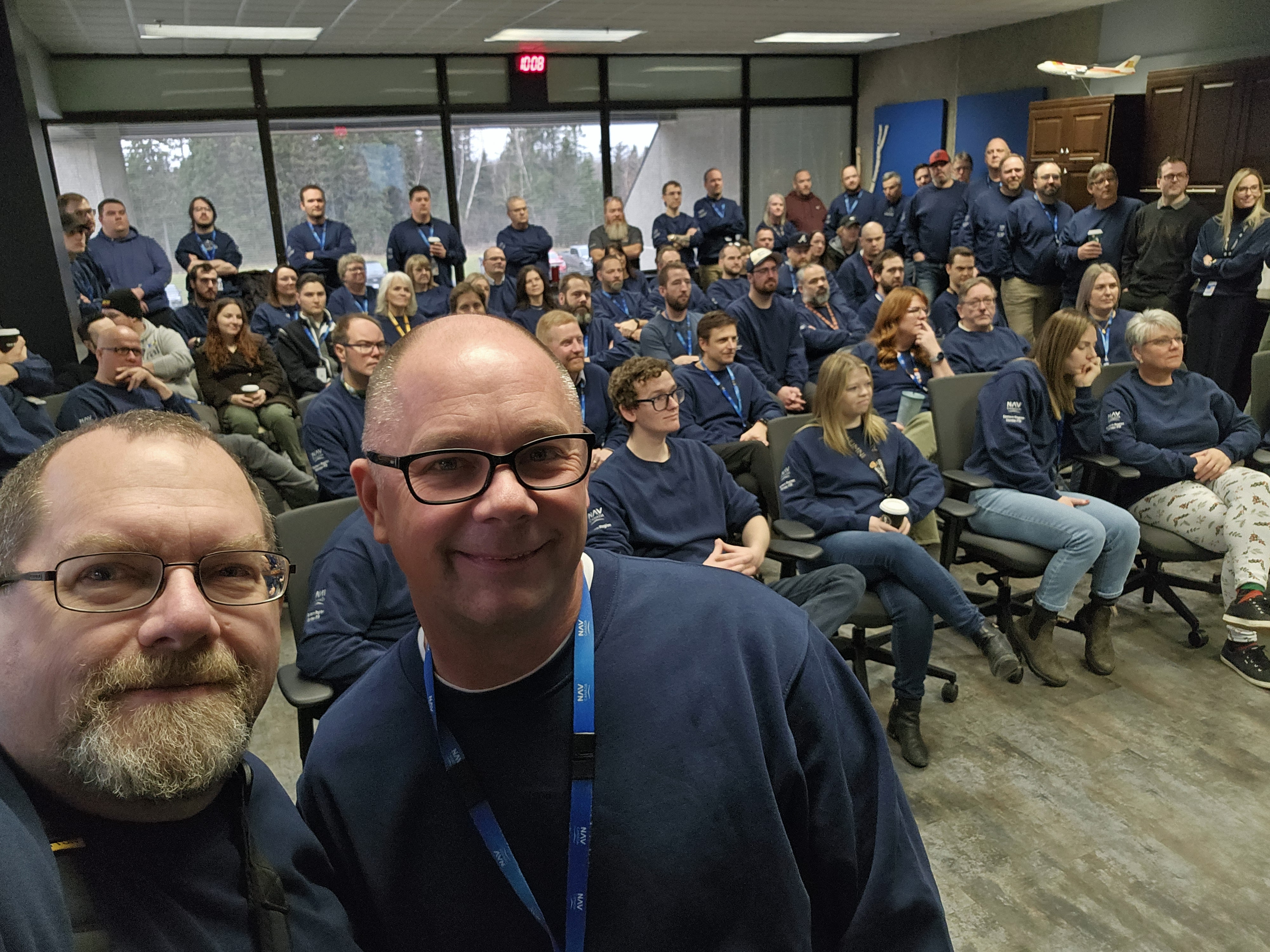







January 3, 2025
As 2024 came to an end, the Gander Flight Information Region (FIR) celebrates managing 500,000 flights through Gander Oceanic airspace in one calendar year. This milestone not only reflects the volume of flights, but showcases the teamwork, dedication to safety, and innovative spirit that have shaped Gander's operations over the past decade.

Scott Cook, OTS Supervisor (left), Robert Fleming, Manager of Area Control Centre Operations (right) and the Gander team celebrate the 500K milestone that was reached on December 26, 2024.
Reaching 500,000 flights in under 10 years is no small feat. In comparison, it took 12 years (from 2003 to 2015) for Gander FIR to increase from 300,000 to 400,000 flights per year. Achieving the next 100,000 flights in a significantly shorter time span, despite the pandemic’s impact on air traffic, is remarkable.
“This milestone is a reflection of the years of hard work and collaboration across our teams,” says Robert Fleming, Manager of Area Control Centre Operations at NAV CANADA in Gander, Newfoundland . “Without the two-and-a-half years of slowed traffic during COVID, we would have hit 500,000 flights by 2021. But we’re still very proud to celebrate this achievement in 2024.”
This significant increase in air traffic shows Gander FIR’s ability to scale up and adapt its services to meet global demand. “Managing such a high volume of traffic without compromising on safety or service quality is one of our greatest accomplishments. We’ve made the North Atlantic one of the safest airspaces in the world,” Fleming says. “However, this growth would not have been possible without the unwavering dedication and resilience of our entire team.”
This achievement also wouldn’t have been possible without key technological innovations and procedural improvements that have transformed how air traffic is managed over the North Atlantic. These advancements have significantly increased capacity on the North Atlantic Tracks (NAT) while reducing constraints for NAV CANADA customers.
One major advancement is the replacement of high-frequency (HF) communication transmitters and receivers, which allows Gander to maintain long-range communication over the ocean, essential in areas like the North Atlantic.
In addition, the introduction of Space-Based ADS-B has been a game-changer. What was once considered a "black hole" for air traffic—an area where aircraft were largely out of reach of surveillance—is now fully monitored. Every flight is continuously tracked, greatly enhancing safety, efficiency, and controller awareness.

Technological advancements like Space-Based ADS-B (seen on the screens) have contributed to Gander’s achievement of reaching 500,000 flights in under one year.
Safety remains the cornerstone of Gander FIR’s operations, even as demand has surged. “Gander achieved zero minutes of unprotected time in six of the last seven Scrutiny Group Sessions,” Fleming notes, referring to the periods when an aircraft is not actively monitored by air traffic control. “This accomplishment reflects not just our processes, but also Gander’s unwavering focus on safety.”
At the same time, Gander has continued to deliver excellent service, with 80% of flights getting their preferred routing or altitudes. “This consistency is commendable, especially given that external factors—like two flights requesting the same altitude arriving at a common fix at the same time—can affect service metrics,” Fleming says.
Programs like the Gander Oceanic Flight Level Initiative, which allows the availability of real-time altitude changes, provides more flexibility to flight crews. Additionally, by enabling economic speed operations—where aircraft can fly at their most fuel-efficient speeds for a given set of conditions—Gander has helped airlines save hundreds of tons of fuel daily.
“Throughout this period of growth, our team has worked diligently to uphold the highest safety standards. Every procedure, technology, and decision, prioritizes safety. At the same time, our ability to balance increased capacity with consistent service delivery is a key factor in reaching this milestone."
“This milestone is a testament to the collective effort of our entire team,” Fleming emphasizes. “From training new staff, to managing increasing traffic, to supporting the day-to-day needs that keep this company running, our people are essential. Every task, no matter how big or small, plays a part in ensuring we deliver exceptional service while ensuring safety.”
As traffic grows, training remains a critical focus, with 45 students currently progressing through the system and an increase to 60 expected next year. These efforts underscore the dedication of the team to prepare for the future while continuing to meet today’s challenges with professionalism and collaboration.
As Gander FIR celebrates this achievement, the team is already looking to the future. “Gander will continue to be a world leader in trans-Atlantic flights thanks to continued innovation and ongoing collaboration,” Fleming says. “This milestone reflects years of hard work and dedication, not just in achieving this volume of flights but in maintaining the highest standards of safety and service. It’s an exciting time and we are ready for what comes next .”

The Gander team has balanced increased capacity with consistent service delivery, a key factor in reaching the milestone.
As we continue to keep our skies safe, we are responding to the evolving landscape of aviation and the needs of our customers while creating a more resilient organization for the future.